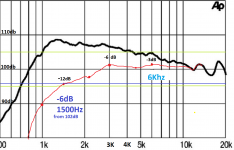Well, it can in theory handle a ~ 1.45 kHz/2nd order or ~ 1.27 kHz/4th order in a HIFI/HT app...........
for 8 watts and using standard hifi requirements (102dB/2.83v/1m) you need an sensivity of 93dB in theory as 8 watt gives 9dB gain (each doubling in watt is +3dB). But that is the mathematical theory. in reality most people listen between 65 and 90dB loud (and 90dB is very loud inside a standard living room) so see if it fits your requirement.
Edit: fyi: 2.83v (RMS) is 1W in 8R on an amp
Edit: fyi: 2.83v (RMS) is 1W in 8R on an amp
Well, it can in theory handle a ~ 1.45 kHz/2nd order or ~ 1.27 kHz/4th order in a HIFI/HT app...........
6 Kz First order would be fine?
Because the frequency resposne would be perfect for me with 6dB/oct
Hmm, [1.8*0.81]*4 = 5.832 kHz, so 6 kHz works for me WRT driver protection in a non prosound app.
Hmm........
ln[6000/1000]/ln[2] = 2.585 octaves * -6 dB = -15.5098 dB
OK and yes, I see now that in my haste I took a too simplistic view, forgetting the driver's, XO roll-off below Fs, so the XO point will be somewhere between 7.2 - 1.44 kHz.
ln[6000/1000]/ln[2] = 2.585 octaves * -6 dB = -15.5098 dB
OK and yes, I see now that in my haste I took a too simplistic view, forgetting the driver's, XO roll-off below Fs, so the XO point will be somewhere between 7.2 - 1.44 kHz.
I thought about this frequency response by cutting the driver at 6kz 6dB / oct, taking into account the 18Sound factory diagram.
Attachments
Last edited:
The Le on the woofer is a bit high and indicates a 745hz high frequency limit. Maybe look at the Faital Pro 12PR330 crossed at 1500 or lower.
I already have the Beyma Sm110-n.
And I don't think 750hz is the upper limit of a woofer with 38grs of moving mass, and 2in voice coil.
And I don't think 750hz is the upper limit of a woofer with 38grs of moving mass, and 2in voice coil.
Good evening scholl,The Le on the woofer is a bit high and indicates a 745hz high frequency limit. Maybe look at the Faital Pro 12PR330 crossed at 1500 or lower.
can you explain me why Le is limiting the upper frequency response of a woofer? I found that the SM110/N does behave better in a small box than the Faital 10PR320 does. They both do extend as much in the sub bass, but the Beyma driver is not sacking in the bass region as the Faital does.
santitrucco, any experiences yet with your drivers?
Regards
Le is the voice coil inductance and for frequency analysis it can be considered to be in series with the voice coil DC impedance - Re.
These who together form an low pass filter for the current though the voice coil and when the frequency of the applied signal to the speaker passes Re/(2*Pi*Le) the current though the voice coil starts roll off with 6dB/octave.
So the greater Le the lower frequency for the roll off.
Warning: This is a very simplistic analysis and in the real world other things starts to influence the frequency response (like membrane breakup).
But it does explain the consequnce of a high Le
Cheers,
Martin
These who together form an low pass filter for the current though the voice coil and when the frequency of the applied signal to the speaker passes Re/(2*Pi*Le) the current though the voice coil starts roll off with 6dB/octave.
So the greater Le the lower frequency for the roll off.
Warning: This is a very simplistic analysis and in the real world other things starts to influence the frequency response (like membrane breakup).
But it does explain the consequnce of a high Le
Cheers,
Martin
Thank you Martin,
I understand the formula but I cannot see the roll off happening in the response of the driver:
Beyma SM-110/N - 10" Woofer
They state it can be used up high:
https://www.beyma.com/speakers/Fich...akers-data-sheet-low-mid-frequency-SM110N.pdf
I understand the formula but I cannot see the roll off happening in the response of the driver:
Beyma SM-110/N - 10" Woofer
They state it can be used up high:
https://www.beyma.com/speakers/Fich...akers-data-sheet-low-mid-frequency-SM110N.pdf
Correct and this is where the isolated assessment of Le comes under pressure as being to simple.
The membrane will start to break up (the rings visible in the membrane indicates that Beyma has designed a controlled break up) and this will influence the frequency response - typically by extending the frequency range.
However be aware that the claimed frequency range and the graph only applies on-axis: Depending on how well Beyma designed and implemented the membrane breakup you should expect "beaming" to set in somewhere between 1 kHz and 2 kHz.
In other words: On-axis you may get output to 6 kHz, but with a listening position just a little bit of-axis you will loose mid and treble.
Unfortunately Beyma does not show this for their low frequency speakers.
Cheers,
Martin
The membrane will start to break up (the rings visible in the membrane indicates that Beyma has designed a controlled break up) and this will influence the frequency response - typically by extending the frequency range.
However be aware that the claimed frequency range and the graph only applies on-axis: Depending on how well Beyma designed and implemented the membrane breakup you should expect "beaming" to set in somewhere between 1 kHz and 2 kHz.
In other words: On-axis you may get output to 6 kHz, but with a listening position just a little bit of-axis you will loose mid and treble.
Unfortunately Beyma does not show this for their low frequency speakers.
Cheers,
Martin
- Home
- Loudspeakers
- Multi-Way
- Beyma SM110/n for 2 way low power speakers.
